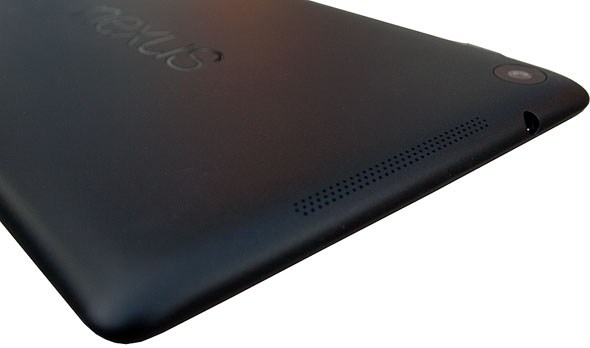Google Nexus 7 (2013): The Best Android Tablet Yet
Design and User Interface
The difference in size and weight between the original Nexus 7 and 2013's model isn't dramatic, but noticeable when placed side-by-side and/or held in different hands. Slimmer and lighter, the updated Nexus 7 measures 0.3 inches (H) by 7.9 inches (W) by 4.5 inches (D) and weighs 11.2 ounces, compared to the original Nexus 7's dimensions of 0.4 inches (H) by 7.8 inches (W) by 4.7 inches (D) and 12 ounces.
In portrait mode, the 2013 Nexus 7 is slightly taller than last year's model, and the front-facing camera has been moved from the top-center to an offset position towards the right. The megapixel count (2.1MP) is unchanged. Also the same is the thick bezels that line the top and bottom in portrait or left and right in landscape model. The other two bezels are noticeably slimmer, having been cut down about in half. It actually looks uncomfortably thin, but in real-world use, we didn't experience accidental finger taps, or at least not any more than usual.
The new Nexus 7 is a sleeker looking tablet, not just because it's been trimmed down and is less chunky, but also because of the all-black design. Gone is the silver bezel accent that ran the circumference of the original, now replaced by an all-black edge. And while the corners are still rounded, they're smaller and curve at a sharper angle.
For some, the display alone is reason to upgrade from the first generation Nexus 7. Everything looks better on the 2013 Nexus 7 as a result of cramming more pixels into the same surface area, and we found that the display gets a little brighter, too. Navigating the icons isn't a hugely different experience, and you might be hard pressed to tell one tablet from the other based on the menu items alone, but as soon as you fire up a picture or a movie, the Full HD 1080p panel springs to life. It also offers a great viewing experience from virtually any angle.
Google and ASUS traded the textured back finish that was an ergonomic highlight of the original for a smoother backside. They also rotated the ingrained NEXUS logo so that it runs left-to-right in a landscape orientation instead of portrait. This offers a little bit of a textured grip, but not as much as before. Not to overstate the issue, the new Nexus 7 isn't slippery, it just doesn't offer as much friction as the previous design.
New to the rear of the Nexus 7 is a 5MP camera. This was an unfortunate omission of the first generation Nexus 7, and one that ASUS justified by saying it would rather nix the camera altogether than to implement a crappy lens at the desired price point just for the sake of having one. Even though it was a bummer, we understood the reasoning, and we're glad to see that a serviceable set of optics fit within the manufacturing budget this time around.
 |
 |
You'll still find the power button and volume rocker on the upper-right side of the Nexus 7, though just around the corner (literally) is the new position of the 3.5mm audio jack. It's been moved to the top towards the right side just above the rear-facing camera. We're rather indifferent to its placement, though we imagine there will be those who wholeheartedly like and vehemently dislike the change.
That means the microUSB port on the bottom is now all by its lonesome self. If you peer closely, you'll notice it juts out just a tad, and that's probably because the new model is slimmer than the original. It should also be noted that the microUSB port is a SlimPort, so if you have (or purchase) a SlimPort adapter, you can mirror video over HDMI to your HDTV.
Dual stereo speakers now don the Nexus 7 on the left and right side of the tablet. This delivers a marginal improvement in the overall sound quality, though we were slightly disappointed that it's not really any louder than the original. To be fair, a high-end speaker system on a tablet would add to the cost and weight of the device, but we still wish it would pump out a tad more volume. If that's what you need, you can always plug in a set of headphones or connect to an external speaker via Bluetooth. As it stands, the built-in speakers offer rich audio and enough distortion-free volume for a tablet this size, just not enough to rupture your eardrums.

The latest version of Android (4.3) ships with the newest Nexus 7 tablet, and an upgrade is available for last generation Nexus 7 owners, as well. Most users won't find the changes to be immediately obvious, though if you've kept up with Google's evolving Android platform, you'll there are certain features to look for, one of the highlights being multi-user restricted profiles. Essentially a version of parental controls, multi-user restricted profiles lets you lock the kids out from accessing certain content and features, like in-app purchases. This requires a bit of cooperation from the developer side, as it up to app programmers to code in support for these controls, but at least there's an option for them.
You'll also find emoticons for the stock keyboard, lower latency input for gamepad buttons and joysticks, Bluetooth Smart (or Bluetooh Low Energy) support, and a few other upgrades.











